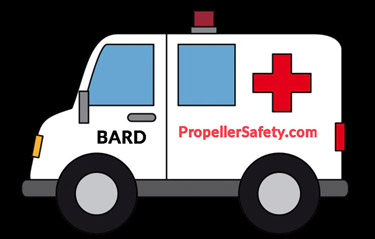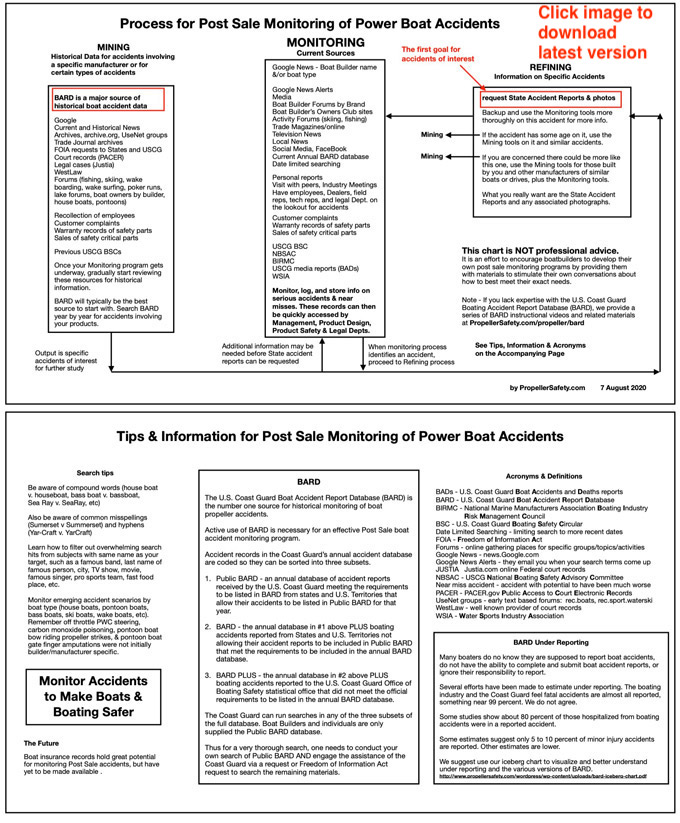BARD: Boat Manufacturer Post Sale Safety Monitoring chart
Post Sale Monitoring is sometimes called Post Sale Surveillance or Post Market Surveillance.
The BARD database has some quirks and shortcomings, but it is the best tool available to identify boat accidents by manufacturer this side of insurance records which are not publicly available.
We now provide a number of BARD training videos and support materials to assist boat builders using BARD as part of their post sale safety monitoring program. This page features a large chart showing how BARD can fit into a broader program to post sale monitor accidents involving vessels built by a specific boat builder.
This post and the accompanying chart are NOT professional advice. They are educational materials to stimulate further discussion of the topic and to provide boat builders a place to start when developing their own Post Sale monitoring programs.
Perceived High Barriers to Entry
We suspect many boat builders fail to utilize the Public BARD database due to perceived high barriers to entry (challenges encountered when they try to find or start to use BARD). Those perceived barriers include the complexity of the database, their lack of familiarity with Microsoft Access, their lack of access to Microsoft Access, they feel BARD has a steep learning curve and they do not have the time to invest in figuring out how to run it. In reality boat builders may not recognized the value BARD could provide to their safety efforts. BARD may just need a Public Relations team. We try to do some of that in our video tutorials as well.
Another reason we suspect boat builders fail to utilize the database is fear of what they may find in there. We can’t do anything about that, but the faster you are able to identify any safety challenges your products may have, the faster you can begin to address them, and the fewer similar accidents that occur.
A little encouragement – Don’t stick you head in the sand, get out there and use BARD and other tools to monitor the Post Sale safety of your boats or marine drives and make them safer. Ignorance is not bliss when it comes to product safety.Chart of Process for Post Sale Monitoring of Power Boat Accidents by Boat Builders
In 2020 we launched a Process for Post Sale Monitoring of Power Boat Accidents chart showing how boat builders could use BARD and other tools to Post Sale (after sale) monitor boat accidents involving their vessels. That information could then be used to make their vessels safer. Similarly, marine drive manufacturers can monitor boat accidents involving their drives and use that information to design safer products. In some instances it may be necessary for boat builders or marine drive manufacturers to directly address problems on boats still in the field using a service bulletin, product recall, letter, warning, social media outreach, or some other means.
Requesting Assistance From the U.S. Coast Guard
As explained on our chart above, the U.S. Coast Guard has access to accidents in their database you cannot see in Public BARD.
You can request their assistance in searching for accidents involving your vessels. We strongly encourage you to first search Public BARD on your own. Depending on the situation, you may be able to request the Coast Guard for assistance or you may need to send them a Freedom of Information Act request for the data you seek.
SOMETIMES they will be able to provide at least a portion of the records from states and territories not making their records available in Public BARD. For example certain data may be redacted from those records such as the Hull ID number. The Coast Guard may be able to count the records they are not able to supply. For example the Coast Guard might say we found 20 of your accidents for which we are unable to provide individual records. You could ask the Coast Guard in advance to characterize accidents records they were unable to provide. For example you could ask them to count them by model year (list how many accident for each model year of boat) OR to count them by model (list how many accident for each of your boat models) Or to count them by state (list how many of your accidents happened in each state, OR to count the number of injury accidents and the number of fatality accidents, OR by whatever variables would be of most use to you. Characterizing the accident records by meaningful variables provides more insight than just a count of the accidents you cannot see.
Our Previous Post Sale Monitoring Publications
USCG BARD as a Tool for Boating Safety Continuous Improvement 25 July 2012.
Below are links to a series of articles we wrote on the use of BARD as a post sale monitoring tool in 2014.
1. Handout summarizing our coverage
2. Post Sale Duty to Monitor Product Risks / Accidents: Boating Industry
3. Moral Responsibility to Monitor Products Post Sale: Boating Industry
4. How to Monitor Boating Product Accidents / Risks Post Sale
5. Full access to BARD is CRITICAL for monitoring product safety after sale
6. We encourage you to return to item #1 the summary handout
Comments
If our videos and related materials have inspired you or your firm to take some actions to utilize BARD data in your efforts, please drop us a note or comment below and tell us about it.


